Cell Injury | What Is Cell Injury?
Cell injury is the common denominator in almost all diseases. It is defined as ‘an
alteration in cell structure or biochemical functioning, resulting from some stress that
exceeds the ability of the cell to compensate through normal physiologic adaptive
mechanisms’. Cell injury results when cells are stressed so severely that they are no
longer able to adapt or when cells are exposed to inherently damaging agents or
suffer from intrinsic abnormalities. Different injurious stimuli affect many metabolic
pathways and cellular organelles. Injury may progress through a reversible stage and
culminate in cell death😵.
What Exactly Is Cell Injury And What Are Types Its Categorized Under?
Cell injury results when cells are stressed so severely that they are no longer able to adapt or when cells are exposed to inherently damaging agents or suffer from intrinsic abnormalities Injury may progress through a reversible stage and culminate in cell death.
They Are Mainy 2 Major Categories
1) Reversible cell injury
2) Irreversible cell injury (Cell death)
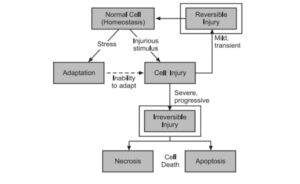
-
A). Reversible cell injury🔀:
In early stages or mild forms of injury the functional and morphologic changes are reversible if the damaging stimulus is removed. At this stage, although there may be significant structural and functional abnormalities, the injury has typically not progress to severe membrane damage and nuclear dissolution.
-
B). Irreversible cell injury (Cell death)🔇🤫:
Because of cell death with continuing damage, the injury becomes irreversible, at
which time the cell cannot recover and it dies. There are two types of cell death,
necrosis and apoptosis which differ in their morphology, mechanisms, and roles in
disease and physiology. When damage to membranes is severe, enzymes leak out of
lysosomes, enter the cytoplasm, and digest the cell, resulting in necrosis. Cellular
contents also leak out through the damaged plasma membrane and elicit a host reaction
(inflammation). Necrosis is the major pathway of cell death in many commonly
encountered injuries, such as those resulting from ischemia, exposure to toxins, various
infections and trauma. When a cell is deprived of growth factors or the cell’s DNA
or proteins are damaged beyond repair, the cell kills itself by another type of death,
called apoptosis, which is characterized by nuclear dissolution without complete loss of
membrane integrity. Apoptosis is an active, energy dependent, tightly regulated type of
cell death that is seen in some specific situations. Whereas necrosis is always a
pathologic process, apoptosis serves many normal functions and is not necessarily
associated with pathologic cell injury.
- i. Necrosis:
Necrosis is one of the, basic patterns of irreversible cell injury and death. Necrosis has long been considered the “unregulated” pattern of cell injury and death, representing a messy end to a damaged cell that consequently causes a potent inflammatory response.
- ii. Apoptosis:
This is a pathway of cell death that is induced by a tightly regulated suicide program in which cells destined to die by activating enzymes capable of degrading the cell’s own nuclear DNA, nuclear and cytoplasmic proteins. Fragments of the apoptotic cells then break off; giving the appearance that is responsible for the name (apoptosis, “falling off”). The plasma membrane of the apoptotic cell remains intact, but the membrane is altered in such a way that the cell and its fragments become avid targets for phagocytes. The dead cell is
rapidly cleared before its contents have leaked out, and therefore cell death by this
pathway does not elicit an inflammatory reaction in the host. Thus, apoptosis differs
from necrosis, which is characterized by loss of membrane integrity, enzymatic digestion
of cells, leakage of cellular contents, and frequently a host reaction. However,
apoptosis and necrosis sometimes coexist,and apoptosis induced by some pathologic
stimuli may progress to necrosis.
Related: Positive Feedback Mechanism Vs Negative Feedback Mechanism| Adaptation | Homeostasis
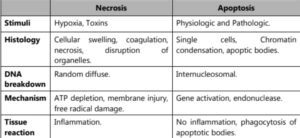
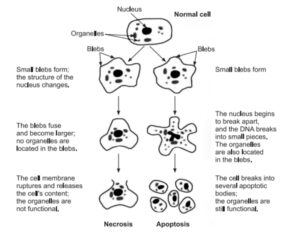
Etiology of Cell Injury
Cell injury is a sequence of events that occur if the limits of adaptive capability are exceeded or no adaptive response is possible. This can be due to
physical, chemical, infectious, biological, immunological factors and nutritional
cellular abnormalities.
-
A) Acquired cause:⚕️
Acquired causes of cell injury are further
categorized as:
- (1) Oxygen deprivation (Hypoxia)
- (2) Physical agents
- (3) Chemical agents and drugs
- (4) Microbial agents
- (5) Immunologic agents
- (6) Nutritional derangement
- (7) Psychological factors
- (8) Idiopathic agents
- Oxygen deprivation: Hypoxia is adeficiency of oxygen, which causes cell injury by reducing aerobic oxidative respiration. Hypoxia is an extremely important and common cause of cell injury and cell death. Causes of hypoxia include reduced blood flow (ischemia), inadequate oxygenation of the blood due to cardiorespiratory failure, and decreased oxygen-carrying capacity of the blood, as in anemia or carbon monoxide poisoning (producing a stable carbon monoxyhemoglobin that blocks
oxygen carriage) or after severe blood loss. Depending on the severity of the
hypoxic state, cells may adapt, undergo injury, or die. For example, if an artery is
narrowed, the tissue supplied by that vessel may initially shrink in size (atrophy), whereas more severe or sudden hypoxia induces injury and cell
death. - Physical agents for cell injury :Mechanical trauma (e.g., Road accident), Thermal trauma (e.g., Heat and cold),Electricity, Radiation (e.g., U.V. radiation),Rapid changes in atmosphere pressure.
- Chemicals and Drugs: The list of chemicals that may produce cell injury
defines compilation. Simple chemicals such as glucose or salt in hypertonic concentrations may cause cell injury directly or by deranging electrolyte balance in cells. Even oxygen at high concentrations is toxic. Trace amounts of poisons, such as arsenic, cyanide or mercuric salts, may damage sufficient number of cells within minutes or hours
to cause death. Other potentially injurious substances are our daily companions: environmental and air pollutants, insecticides, and herbicides; industrial and occupational hazards, such as carbon monoxide and asbestos; recreational drugs such as alcohol; and
the ever-increasing variety of therapeutic drugs. - Microbial agents: Injuries by microbesinclude infection caused by bacteria,rickettsiae, viruses, fungi, protozoa andother parasites.
- Immunological Agents: The immunesystem serves an essential function indefence against infectious pathogens,but immune reactions may also causecell injury. Injurious reactions to endogenous self-antigens are responsible for several autoimmune diseases. Immune reactions to many external agents, such as viruses and environmental substances, are also important causes of cell and tissue injury. Example: Hypersensitivity reactions, anaphylactic reactions,autoimmune diseases.
- Nutritional derangement: A deficiency or an excess of nutrients may results in nutritional imbalances. Nutritional deficiency diseases may be due to overall deficiency of nutrients (starvation), protein calorie (Marasmus,Kwashiorkor), and minerals (Anaemia) or of trace elements. Nutritional excess is a problem of society which results from
obesity, in atherosclerosis, heart diseases and hypertension. - Psychological factors: There are number of specific biochemical or morphological changes in common acquired mental diseases due to mental stress, strain, anxiety, overwork and frustration. Problems of drug addiction, alcoholism and smoking results in
various diseases such as liver damage, chronic bronchitis, lung cancer, peptic
ulcer, hypertension, ischemic heart diseases etc. - Idiopathic factor: The causative factor of cell injury is unknown.
-
B) Genetic cause:🧬
In western countries, genetic defects constitute about 50% total mortality in infancy and childhood, while in developing and under developing countries 95% of infant mortality occurs. Genetic cases are such as, Developmental defect (Errors in morphogenesis), cytogenic defects (chromosomal abnormalities), Single-gene defects (Mendelian syndrome), Storage diseases (Inborn Errors of metabolism), Disorders with multifactorial inheritation.
Pathogenesis of Cell Injury 🩺| Morphology of cell injury⚕️
Cell damage can be reversible or irreversible. Depending on the extent of injury, the cellular response may be adaptive and homeostasis is maintained. Cell death occurs when the severity of the injury (Stress) exceeds the cell’s ability to repair itself. Cell death is relative to both the length of exposure to a harmful stimulus and the severity of the damage caused. Cell death may occur by severe cell swelling or cell rupture, denaturation and coagulation of cytoplasmic proteins and breakdown of cell organelles (necrosis)
or internally controlled cell death, chromatin condensation and fragmentation (apoptosis). Now, we have discussed the causes of cell injury and necrosis and their morphologic and functional correlates, we next consider in more detail the molecular basis of cell injury, and then illustrate the important principles with a few selected examples of common types of injuries. The biochemical mechanisms linking any given injury with the resulting cellular and tissue manifestations are complex, interconnected, and tightly interwoven with many
intracellular metabolic pathways. It is therefore often difficult to pinpoint specific molecular alterations caused by a particular insult. The cellular response to injurious stimuli
depends on the type of injury, its duration, and its severity. Thus, low doses of toxins or
a brief duration of ischemia may lead to reversible cell injury, whereas larger toxin
doses or longer ischemic intervals may result in irreversible injury and cell death.
The consequences of an injurious stimulus depend on the type, status, adaptability, and genetic makeup of the injured cell. The same injury has vastly different outcomes
depending on the cell type; thus, striated skeletal muscle in the leg accommodates
complete ischemia for 2 to 3 hours without irreversible injury, whereas cardiac muscle
dies after only 20 to 30 minutes. The nutritional (or hormonal) status can also be
important; clearly, a glycogen-replete hepatocyte will tolerate ischemia much
better than one that has just burned its last glucose molecule. Genetically determined
diversity in metabolic pathways can also be important. For instance, when exposed to
the same dose of a toxin, individuals who inherit variants in genes encoding
cytochrome P-450 may catabolize the toxin at different rates, leading to different
outcomes. Much effort is now directed toward understanding the role of genetic
polymorphisms in responses to drugs and toxins and in disease susceptibility.
Cell injury results from functional and biochemical abnormalities in one or more of
several essential cellular components. The most important targets of injurious stimuliare:
- Mitochondria, the sites of ATP
generation - Cell membranes, on which the ionic
and osmotic homeostasis of the cell
and its organelles depends - Protein synthesis
- The cytoskeleton, and
- The genetic apparatus of the cell.
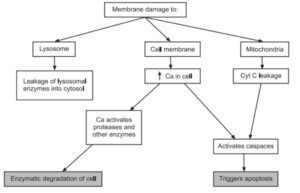
A) Mechanism of Reversible Cell Injury⚕️:
As the name implies, this occurs if extreme stress persists and the cell is unable to adapt to overcome the stress. Reversible cell injury results in cellular and morphological changes that can still be reversed if the stress is eventually removed. There are three mechanisms by which reversible cell injury may occur.
- Depleted resources of ATP in the cell
owing to decreased levels of
Oxidative Phosphorylation. - Hydropic cellular swelling, a
phenomenon caused by changes in
ion concentrations and water influx. - Organelles within the cell show
minute alterations.
a) ATP depletion: ATP depletion and decreased ATP synthesis are frequently associated with both hypoxic and chemical (toxic) injury. High-energy phosphate in the form of ATP is required for many synthetic and degradative processes within the cell. These include membrane transport, protein synthesis, lipogenesis, and the deacylation reacylation reactions necessary for phospholipid turnover. Depletion of ATP to 5% to 10% of normal levels has widespread effects on many critical cellular systems. The activity of the plasma membrane energy dependent sodium pump is reduced. Failure of this active transport system, due to diminished ATP concentration and enhanced ATPase activity, causes sodium to accumulate intracellularly and potassium to diffuse out of the cell. The net gain of solute
is accompanied by isosmotic gain of water, causing cell swelling, and dilation of the
endoplasmic reticulum and cellular energy metabolism is altered. If the supply of
oxygen to cells is reduced, as in ischemia, oxidative phosphorylation ceases and cells
rely on glycolysis for energy production. This switch to anaerobic metabolism is
controlled by energy pathway metabolites acting on glycolytic enzymes.
The decrease in cellular ATP and associated increase in adenosine
monophosphate stimulate phospho fructo kinase and phosphorylase activities. These
result in an increased rate of anaerobic glycolysis designed to maintain the cell’s energy sources by generating ATP through metabolism of glucose derived from glycogen. As a consequence, glycogen stores are rapidly depleted.
Glycolysis results in the accumulation of lactic acid and inorganic phosphates from
the hydrolysis of phosphate esters. This reduces the intracellular pH, resulting in
decreased activity of many cellular enzymes.
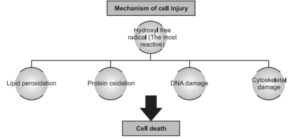
- b) Damage to Mitochondria:
Mitochondria are the cell’s suppliers of life sustaining energy in the form of ATP, but they are also critical players in cell injury and death. Mitochondria can be damaged by increase of cytosolic Ca2+, reactive oxygen species, and oxygen deprivation, and so they are sensitive to virtually all types of injurious stimuli, including hypoxia and
toxins.
There are two major consequences of mitochondrial damage:
- Mitochondrial damage often results in the formation of a high-conductance
channel in the mitochondrial membrane, called the mitochondrial permeability ransition pores. The opening of this channel leads to the loss of mitochondrial membrane potential and pH changes, resulting in failure of oxidative phosphorylation and progressive depletion of ATP, culminating in necrosis of the cell. - The mitochondria also contain several proteins that are capable of activating
apoptotic pathways, including cytochrome C (the major protein
involved in electron transport). Increased permeability of the mitochondrial
membrane may result in leakage of these proteins into the cytosol and
death by apoptosis. Thus, cytochrome C plays a key dual role in cell survival and death. In its normal location inside mitochondria, it is essential for energy
generation and the life of the cell, but when mitochondria are damaged so
severely that cytochrome C leaks out, it signals cells to die.
- c) Influx of Calcium: Failure of the Ca2+ pump leads to influx of Ca2+, with damaging effects on numerous cellular components. With prolonged or worsening depletion of ATP, structural disruption of the protein synthetic apparatus occurs, manifested as detachment of ribosomes from the rough endoplasmic reticulum and dissociation of polysomes into monosomes, with a consequent reduction in protein synthesis. Ultimately, there is irreversible damage to mitochondrial and lysosomal membranes, and the cell undergoes necrosis. In cells deprived of oxygen or glucose, proteins may become misfolded, and misfolded proteins trigger a cellular reaction called the unfolded protein response that may lead to cell injury and even death. A protein misfolding is also seen in cells exposed to stress, such as heat, and when proteins are damaged by enzymes and free radicals.
- 1. Defects in membrane permeability:
Early loss of selective membrane permeability leading ultimately to over membrane damage is a consistent feature of most forms of cell injury. The plasma membrane can be damaged by ischemia, various microbial toxins, lytic complement components, and a variety of physical and chemical agents. Several biochemical mechanisms may
contribute to membrane damage. - 2. Decreased phospholipid synthesis:
The production of phospholipids in cells may be reduced whenever there is a fall in ATP levels, leading to decreased energy dependent enzymatic activities. The reduced phospholipid synthesis may affect all cellular membranes including the mitochondria themselves, thus exacerbating the loss of ATP. - 3. Increased phospholipid break-down:
Severe cell injury is associated with increased degradation of membrane phospholipids, probably due to activation of endogenous phospholipases by increased levels of cytosolic Ca2+ - 4. ROS: Oxygen-free radicals cause injury to cell membranes by lipid peroxidation, discussed earlier.
- 5. Cytoskeletal abnormalities:Cytoskeletal filaments serve as anchors connecting the plasma membrane to the cell interior. Activation of proteases by increased cytosolic Ca2+ may cause damage to elements of the cytoskeleton.
- 6. Lipid breakdown products: These include unesterified free fatty acids, acyl carnitine, and lysophospholipids, catabolic products that are known to accumulate in injured cells as a result of phospholipid degradation. They have a detergent effect on membranes. They also either insert into the lipid bilayer of the membrane or exchange with membrane phospholipids, potentially causing changes in permeability and electrophysiologic alterations. The most important sites of membrane damage during cell injury are the mitochondrial membrane, the plasma membrane and membranes of lysosomes.
- 7. Mitochondrial membrane damage:
As discussed above, damage to mitochondrial membranes results in decreased production of ATP, culminating in necrosis, and release of proteins that trigger apoptotic death. - 8. Plasma membrane damage:
Plasma membrane damage leads to loss of osmotic balance and influx of fluids and ions, as well as loss of cellular contents. The cells may also leak metabolites that are vital for the reconstitution of ATP, thus further depleting energy stores.
- 9. Injury to lysosomal membranes:
Injury to lysosomal membranes results in leakage of their enzymes into the cytoplasm and activation of the acid hydrolases in the acidic intracellular pH of the injured (e.g., ischemic) cell. Lysosomes contain RNAases, DNAases, Proteases, Glucosidases, and other enzymes. Activation of these enzymes leads to enzymatic digestion of cell components, and the cells die by necrosis.
- 10. Damage to DNA and proteins:
Cells have mechanisms that repair damage to DNA, but if this damage is too severe to be corrected (e.g., after radiation injury or oxidative stress), the cell initiates its suicide program and dies by apoptosis. A similar reaction is triggered by improperly folded
proteins, which may be the result of inherited mutations or external triggers such as free radicals. Since these mechanisms of cell injury typically cause apoptosis.11. Reduced protein synthesis: As a result of continued hypoxia, membranes of
endoplasmic reticulum and Golgi apparatus swell up. Ribosomes are detached from granular endoplasmic reticulum and polysomes are degraded to monosomes, thus dispersing ribosomes in the cytoplasm and inactivating their function. Similarly reduced protein synthesis occurs in Golgi apparatus. Up to this point, withdrawal of acute stress that resulted in reversible cell injury can restore the cell to normal state.
B) Mechanism of Irreversible Cell Injury🔇:
The long term decrease in oxygenated blood supply results in irreversible damage of the cellular structure and functions. The sequence of the reversible cell injury continues and reach into irreversible cell damage (cell death). In irreversible cell injury, the inability of the cell to reverse mitochondrial and plasma membrane dysfunction on reperfusion or reoxygenation. Beside this there is further reduction in ATP continued depletion to proteins, reduced intracellular pH and leakage of lysosomal enzymes into the cytoplasm. These biochemical changes alter the normal functions of cell which are described as follows:
- 1. Mitochondrial damage: As a result ofcontinued decrease in oxygenated blood supply, irreversible cell damage occurs and on reperfusion with injured cell, excess intracellular calcium collects in the mitochondria disabling its function. Morphologically, mitochondrial changes are vacuoles in the mitochondria and deposition of amorphous calcium salts in the mitochondrial matrix.
- 2. Membrane damage: Damage to plasma membrane loses its normal function is the most important event in irreversible cell injury. Due to damage of the plasma membrane, cytosolic influx of calcium in the cell increases. Calcium activates endogenous phospholipase. Activated phospholipase degrade membrane phospholipids progressively which are the main constituents of lipid bilayer membrane. Besides these, activation of lytic enzymes ATPase which causes further depletion of ATP leads to decrease in the synthesis of new phospholipid for replacement.
- 3. Cytoskeletal damage: Activated intra cellular protease or by physical effect of cell swelling, damages of cytoskeleton may lead to irreversible cell membrane injury.
- 4. Nuclear damage: The nucleoproteins are damaged by the activated lysosomal
enzymes such as proteases and endonucleases. Irreversible damage to the nucleus can be in three forms. - Pyknosis: Condensation and clumping of nucleus which becomes
dark basophilic. - Karyorrhexis: Nuclear fragmentation in to small bits dispersed in the
cytoplasm. - Karolysis: Dissolution of the nucleus.
- 5. Lysosomal damage, cell death and phagocytosis:
The lysosomal membranes are damaged and result in escape of lysosomal hydrolytic enzymes. These enzymes are activated due to lack of oxygen in the cell and acidic pH.
These hydrolytic enzymes include, Hydrolase, protease, glycosidase phosphatase, lipase, amylase, RNAase and DNAase which on activation bring about enzymatic digestion of cellular components and hence cell death. The dead cell is eventually replaced by
masses of phospholipids called myelin figures which are either phagocytosed
by macrophages or there may be formation of calcium soaps. Liberated enzymes just mentioned leak across the abnormally permeable cell membrane into the serum, the estimation of which may be used as clinical parameters of cell death. In myocardial infarction, estimation of SGPT, LDH, CKMB and cardiac troponins useful guides for death of heart muscle.
Related Feed🍼🍼
Brain Alert In Human’s⚠️:What’s Exactly Is Stroke 🩺| Types of Stroke⚕️
What To Do After Positive+ve Pregnancy Test🌞? Do Pregnancy Tests Expire🤨?
Unlock the Secret🍑:Learn the Perfect Timing for a Pregnancy Test After Intercourse🍆

